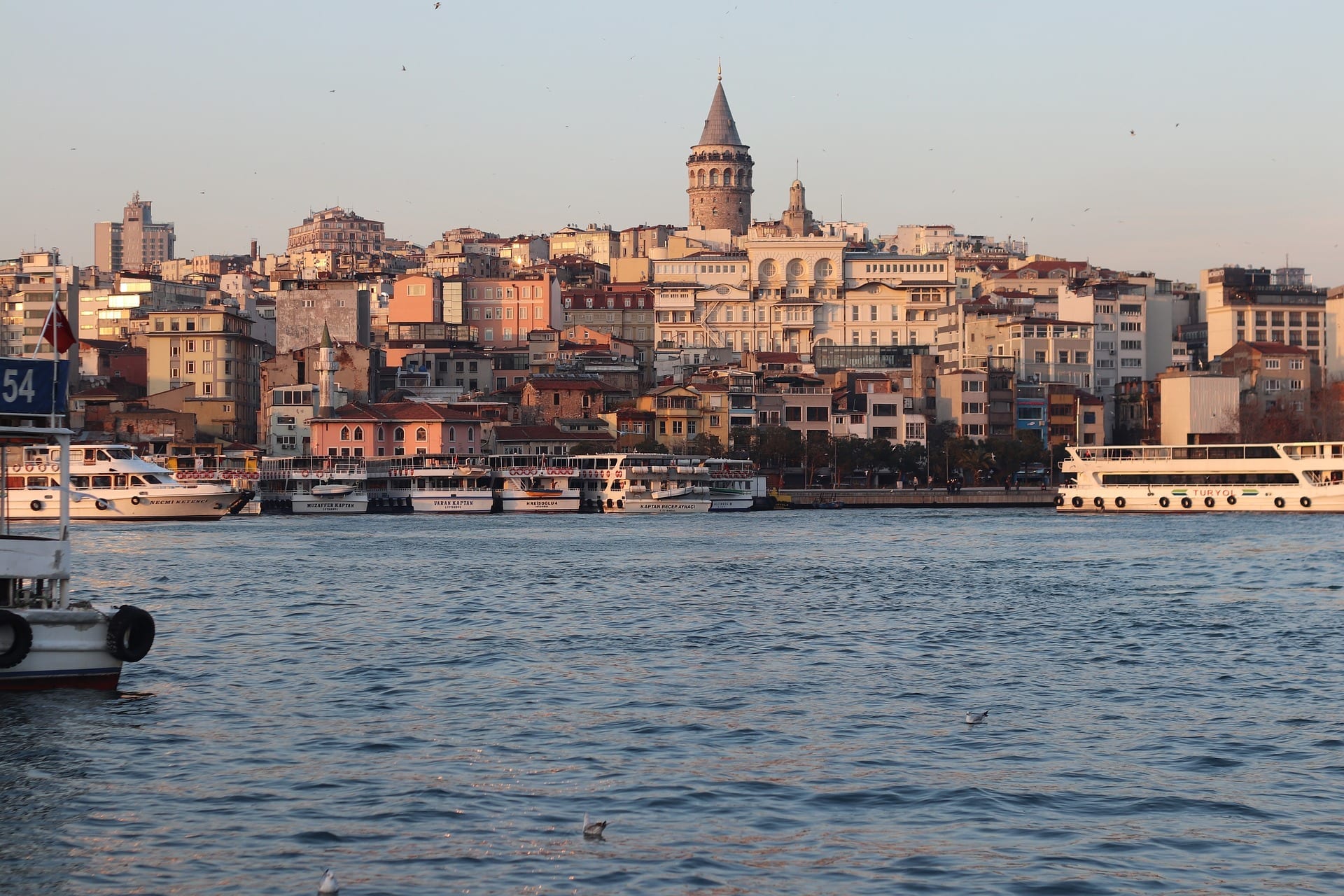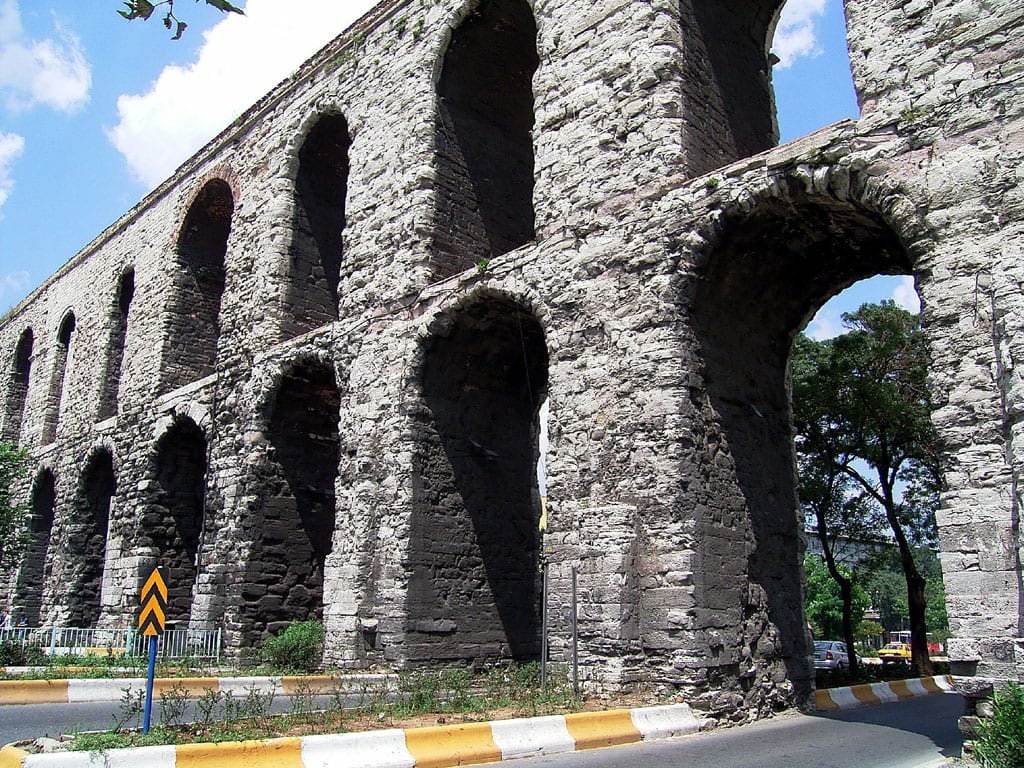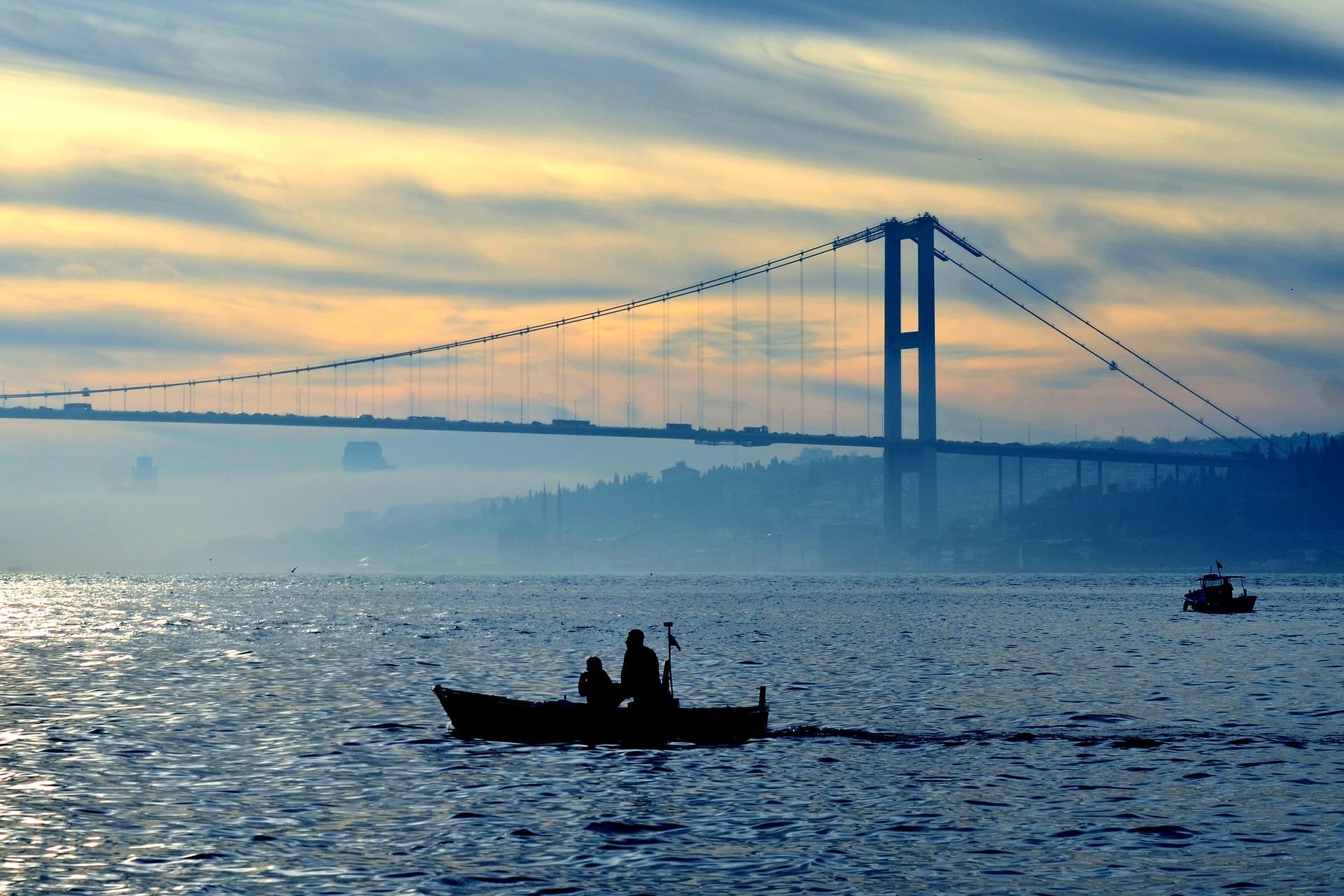Istanbul: City of Water
Sustainability challenge for megacities
Istanbul is a clear example of the sustainability challenges facing humanity with more than 50% of the world’s population now living in urban areas, and with many cities rapidly growing. There are over 300 cities in the world with a population greater than 1 million, and 23 megacities with more than 10 million, including Istanbul. Water is just one of many themes cities need to address, but a critical one that integrates a number of sustainability issues.
Istanbul has faced a complex challenge of meeting its water needs throughout its 2700-year history, previously as Byzantium and Constantinople. Recent large engineering projects have ensured sufficient drinking water for some years to come. But with a large and rapidly growing population, combined with climate challenges, there needs to be constant and careful planning for the future.

Source of identity and survival
Sitting astride the Bosphorus Strait separating Europe and Asia, water is a key component of the city’s identity. With ships travelling north-south along one of the world’s busiest shipping lanes, and with the city’s population traversing the waters, either by ferry, but mostly via one of the two – soon to be three – bridges (a crossing which can take more than an hour at peak times), water is both an asset and a barrier. Unlike many cities sitting on a great river, the seawater of the Bosphorus is not available to drink, or for most other standard water uses, such as for general household use, industry and agriculture. With a dry Mediterranean climate, the options for water supply are limited.
With little groundwater, the city has been dependent on bringing in supplies of fresh surface water from distant streams and lakes. In Roman times, a number of aqueducts were constructed, which eventually deteriorated and fell into disuse. With the advent of the Ottoman Empire in the mid-1400s, new water systems were developed, including renovation of some of the Roman infrastructure. One Roman aqueduct remains a prominent city landmark, the Valens Aqueduct (modern name Bozdogan Kemeri), some 920 meters long in the old Fatih Quarter. The Ottomans also introduced many storage cisterns, at one time establishing a total of a million cubic meters of storage. A highly impressive example still in existence is the Basilica Cistern (Turkish: Yerebatan Sarayı – “Sunken Palace”, or Yerebatan Sarnıcı – “Sunken Cistern”), built in the 6th century with a capacity of 80,000 cubic meters.
Istanbul is now a very large metropolitan city with a population of 14 million, the largest in Europe (ahead of Moscow at 12 million) and with one of the most rapid growth rates at 2.8%. In recent decades, the population has grown at almost twice the overall rate for Turkey, due to urban immigration. Hence, water supply and sanitation have been a particular challenge. The majority of water resources are on the Asian side, whereas the majority of the population – about two thirds – is on the European side. Modern day reservoirs are linked and operate under an integrated and flexible system, which includes a new water transfer tunnel beneath the Bosphoros.
From 2006 to 2008, Istanbul suffered from drought, recording the lowest rainfall in 50 years. Water levels in reservoirs are low now (spring 2014), at only 30% full, thus creating a concern for the summer ahead. Studies show Istanbul has become warmer during the past half century, a trend predicted to continue in combination with a higher frequency of extreme weather events.
In view of the growing demand for water and observed climatic trend, development and adaptation plans have been applied, including water saving campaigns, transfer of water from adjacent basins, and reuse of treated wastewater. Flooding is also an occasional problem with a par- ticularly bad series in 2009.
Modern water management
Water supply and sanitation is the responsibility of the public utility Istanbul Su ve Kanalizasyon Idaresi (ISKI – the Istanbul Municipal Waterworks) created in 1981. Istanbul is supplied with 910 million m3/year (97%) of water from surface water reservoirs and 30 million m3/year water from groundwater. Surface water is collected in seven local water reservoirs, on both sides of the Bosphorus, and a newly connected one, at considerable cost, some 180km to the east in the Melen Basin.
The water systems consist of dams, reservoirs, water treatment plants and pipelines, the total length of pipes being an impressive 17,000km, more than the diameter of the Earth (13,000km). A new addition is a 5km-long undersea water supply tunnel named the Bosphorus Water Tunnel, constructed in 2012 as the final link to the system bringing water from Melen in the east to the European side of the city. Good planning and investment in recent years means the city now has sufficient water supply for some years to come.
Dangers of uncontrolled development
Like many rapidly growing megacities, with large rates of immigration, Istanbul experiences the problem of unauthorized and uncontrolled settlements. Although the reservoirs have conservation zones around them to protect water quality, with restrictions on construction and industrial activity, these are not successfully enforced. Consequently, homes are built, typically without proper sanitation, with the result of pollution finding its way into the reservoirs.
The majority of water resources are on the Asian side, whereas the majority of the population – about two thirds – is on the European side.
This pollution carries nutrients, which provide ‘food’ to algae resulting in algal blooms (eutrophication), which in turn uses up oxygen, making the water unhealthy and unsuitable for a natural wildlife balance. Water pollution also adds to monitoring and treatment costs.

The City blueprint for water
Sustainability encompasses many factors, but water is an ideal theme for assessing and comparing the sustainability and health of cities. Water is critical to so many aspects of human life, especially in cities. This includes: universal access to safe drinking water; wastewater management; flood risk; water scarcity; biodiversity; the aesthetic and amenity value; water energy nexus, and many more.
The City Blueprint concept was developed at the KWR Watercycle Research Institute in the Netherlands, as a baseline assessment of the sustainability of urban water cycle services. The result allows a city to quickly understand how advanced it is in water management and to compare its status with other cities. Istanbul is one of 25 cities to have undertaken the survey.
The survey consists of a review of 24 key indicators for which a score is derived between 0 (poor) and 10 (excellent), with there sult splotted in a spider diagram. In addition, an overall BCI (Blue City Index) score is calculated as the arithmetic mean of the 24 indicators.
The City Blueprint is intended as a first step on a journey of long-term planning and communication and cooperation within and between cities. A key intention is to encourage cities to share best practices, and for all to improve. The program is carried out in the context of the EU’s European Innovation Partnership (EIP) on Water. For more information, visit: www.eip-water.eu
Istanbul’s City blueprint
The results of Istanbul’s City Blueprint are presented, in comparison to two other quite different cities, Dar es-Salaam (Tanzania) and Oslo (Norway). Istanbul scores well in the critical areas of ‘sufficient to drink’, drinking water quality, and safe sanitation, but with low scores in other areas, such as surface water and groundwater quality, public participation and nutrient recovery.
Overall, the results confirm the conclusions of a number of earlier studies, the key one being that conventional strategies to further increase water supply in line with population growth cannot be met indefinitely, so that greater emphasis needs to be placed on a more effective and efficient management of existing water resources. Water quality will remain a major challenge, due to the expanding, sometimes unauthorized settlement of new land, particularly near water reservoirs. Future strategies for success need to include: cooperation among various social levels and organizations, from national and local governments to the private sector and civil society. Effective measures should include education, regulation and appropriate penalties (with enforcement), incentives to reduce water losses and improved recycling and re-use.
Making progress
Istanbul has made excellent progress in ensuring there is sufficient water supply for the city, including provision of safe drinking water. The biggest challenge remains how to manage wastewater and its impact on the natural water environment, including the Bosphorus.
From the City Blueprint survey, only 9% of wastewater was treated in 1993. By 2004, that had increased to 95%. The new part of the wastewater system is a dual system, which means dirty (‘black’) sewer water runs along separate pipes to storm run-off. In many older cities of Europe, and for the older systems in Istanbul, these were combined, which means rainwater and dirty water use the same pipes. The problem with combined systems is that in heavy storms, the system is overwhelmed by rainwater, and must overflow into surface water bodies, causing contamination incidents, poisoning wildlife and creating a health hazard for bathing waters. Istanbul has done well to develop a dual wastewater system. However, unauthorized sewer connections – often to the ‘wrong’ pipe – means that untreated dirty water still reaches water bodies, including the reservoirs.

Golden Horn clean-up
The Golden Horn (Halic or Altın Boynuz in Turkish) is an historic inlet on the European side of the Bosphorus dividing the city of Istanbul, and forming the natural harbor that sheltered Ottoman and other ships for thousands of years. It has faced pollution challenges for centuries, and in fact was the subject of one of the world’s first environmental management policies, in the mid-1400s, when Sultan Mehmet restricted settlement, encouraged forestation to combat erosion and banned local agriculture.
The Golden Horn water body is 7.5km long, 200–900 meterwide horn-shaped body of water connecting two rivers to the Bosphorus Strait. It lies in the center of the historic city and played a substantial role in Istanbul’s culture for thousands of years, particularly for its numerous harbors, abundant fish populations, and recreation grounds. Thriving fisheries were supported until the latter 20th century, when it inevitably became polluted by 40 years of uncontrolled industrial and urban growth resulting in thick layers of anoxic sediment, toxic bacteria, strong hydrogen sulphide odor, and ecologically unliveable conditions.
Water and air circulation are severely hampered in and around the Golden Horn, which has led to a local environment extremely prone to lasting pollution problems. These causes, together with steep hills, the presence of stone quarries, and the absence of drainage systems, all encourage substantial erosion and estuarine sedimentation. The situation was not helped by the building of a dam on the inflowing River Alibeyköy in 1983, reducing the inflow of fresh water and its diluting effect.
Another major source of pollution, Istanbul’s sewer system consisted of drains dating to Roman and Ottoman periods combined with explosive urbanization in the second half of the 20th century and immigration rates. All together, the quality of water, and the quality of life around the Golden Horn was greatly reduced.
A new environmental improvement and management plan was needed. Planning commenced in the 1950s, and major efforts commenced in the 1980s. The main components of restoration included: demolition and relocation of industries and homes along the shore; creation of wastewater infrastructure; removal of anoxic sludge from the estuary; removal of a floating bridge that impeded circulation; and creation of cultural and social facilities. Although Turkey is not known as an environmental leader in pollution control, the sum of these efforts was largely successful in revitalizing the area through dramatic water quality improvement. Consequently, the estuary is once again inhabitable for aquatic life as well as amenable to local resource users and foreign visitors, and Istanbul has regained a lost sense of cultural identity.
Cleaning up of the Golden Horn remains an unfinished project, and will require constant vigilant management. But, it is an example that with the right will and commitment, improvements can be achieved in the most challenging situations. Despite progress in the Golden Horn, the waters around Istanbul, in the Boshporus and Mamara Sea to the south, remain heavily polluted, with reports that fish stocks continue to reduce.
In rapidly growing cities, there will always be a conflict of priorities between economic and social needs and those of the environment. The principal of Smart Cities as promoted by the European Commission, and represented in the City Blueprint concept, is that these must progress handin-hand to ensure sustainable benefits for all.